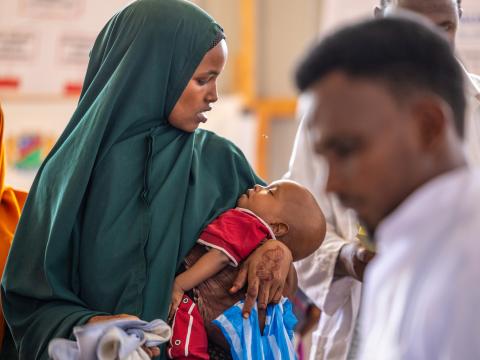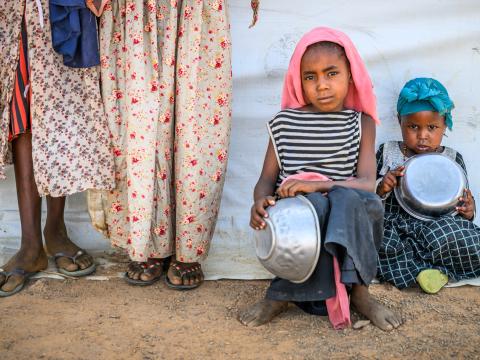
Why Ending Hunger Begins with How We Choose to Act
Dana Buzducea, World Vision’s Partnership Leader for Advocacy and External Engagement, argues that the fight against hunger is not a technical challenge but a test of political will, one the Global Alliance against Hunger and Poverty must not fail.
3 November 2025.
As a social worker and a mother, food and access to food have very deep meaning for me, especially when it comes to children. I can still remember the faces and names of malnourished children I met in my career, desperation of mothers who were trying to put some food on the table or even my own anxiety when my children’s appetite would go down for a few days. Food is in everybody’s mind. Social media abounds on information about the trendy passion for cooking, different food choices or the best weight loss techniques. And all these while a moral and social conundrum is unfolding at our doorsteps: we live in a world that produces enough food for everyone, yet millions of children still go to bed hungry. Hunger today is not inevitable; it reflects the choices, the coordination and the political will to act.
As leaders convene in Doha for First Leaders’ Meeting of the Global Alliance Against Hunger and Poverty (GAAHP), the stakes could not be higher. The world is falling behind. 333 million children still live in extreme poverty. One in six grows up amid conflict. The climate crisis is eroding every child’s right to safety, food, health, and learning widening inequalities and pushing hope further out of reach. And yet, there is still room for optimism. This gathering offers a chance to turn that despair into determination, to move from declarations to delivery, from intent to impact.
The Politics of Hunger
One might contend that hunger is an economic issue, a problem to be solved through better markets, higher yields, and smarter aid. Yet, although such measures are essential, they overlook a deeper truth: hunger can be tackled with the right political will in place.
Opening fiscal space and mobilising financing for the fight against hunger and poverty are not merely technical exercises, they are moral and political decisions about what we value as a global community. They signal the kind of future we wish to build and the generations we intend to protect.
We know what works. Decades of evidence from communities show that when investment reaches families directly in nutrition, livelihoods, school meals, and safety nets children thrive. Still, despite the proof, progress has stalled. Why? Because too often, the global system rewards innovation over implementation, and pledges over performance.
From Evidence to Action
This is why World Vision joined the GAAHP not to add another voice to the chorus of declarations, but to deepen cooperation and ensure that hard-earned evidence from communities informs real-world decisions.
For over 75 years, World Vision has co-created practical, community-driven solutions with families around the world serving all people regardless of religion or background and helping translate local lessons into global policy. Within the Alliance, we see a pathway to accelerate progress through the Fast Track countries provided that partnership is genuine, accountability shared, and governments, civil society, and communities all play their part.
This model is not theoretical. It is happening. From Ethiopia’s Yelemat Tirufat initiative to Zambia’s CASH+ approach, locally led efforts are proving that child-centred, community-rooted strategies can reduce poverty and hunger when properly funded and coordinated.
Investing in What Works
World Vision is investing USD 3.4 billion between 2023 and 2026 to fight hunger and poverty a reaffirmation of our global commitment to accelerate progress for children. Through our ENOUGH Campaign, we are working to eliminate child hunger and malnutrition in all its forms, building on evidence that shows what drives lasting change: partnership, accountability, and persistence.
But investment alone will not suffice. We must also use resources wisely, scale what works, and abandon what doesn’t. This requires courage the courage to scrutinise our own assumptions, to challenge comfortable inefficiencies, and to prioritise impact over visibility.

Delivery Over Delay
To a certain extent, multilateralism is being tested as never before. Fiscal constraints are tightening. Humanitarian needs are rising. Scepticism toward global institutions is growing. But central to this challenge lies an opportunity: to prove that cooperation still works when grounded in trust, evidence, and shared purpose.
If this meeting in Doha is to matter, let it be remembered as the moment we chose delivery over delay when declarations gave way to decisions, and when alliances became instruments of change, not ceremony.
Because when we invest in children, we invest in the future we all share. When we finance hope, we ignite change and when we unite around what truly works, we make that hope real ensuring every child has enough: enough nutritious food, enough opportunity, and enough hope.
With over 30 years of experience, Dana Buzducea is World Vision International’s Partnership Leader for Advocacy and External Engagement, where she leads global efforts to influence child-sensitive social protection policies, strengthen government and multilateral investments and advance both the Sustainable Development Goals and the Convention on the Rights of the Child.


